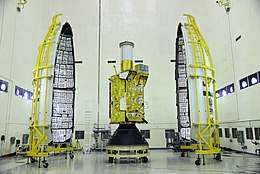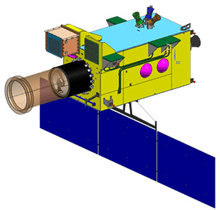GEO Imaging Satellite
Geo Imaging Satellite or GISAT is an Indian imaging satellite class for geostationary orbit with a high temporal resolution, meant for providing near real time imaging with fast revisit capability and real time monitoring.[6] Two identical satellites will provide resolution in the range of 42 to 318 m.[1][7] It will carry multi-spectral (Visible and Near-InfraRed, and Short Wave-InfraRed), multi-resolution (42 to 318 m) imaging instruments.[8]
 GISAT-1 before encapsulation | |
| Manufacturer | ISRO Satellite Centre Space Applications Centre |
|---|---|
| Country of origin | India |
| Operator | ISRO |
| Applications | Earth observation |
| Specifications | |
| Bus | I-2K [1] |
| Design life | 7 years |
| Launch mass | 2268 kg[2][3] |
| Power | 2280 watts [1] |
| Equipment | Ritchey-Chrétien telescope[4] Multispectral array detectors Steerable antenna |
| Regime | Geostationary |
| Dimensions | |
| Production | |
| Status | 2020 (GISAT-1) (planned) August 2020 (GISAT-2) (planned) |
| Launched | 0 (2 planned) |
| Maiden launch | GISAT-1 (2020)[5] (planned) |
Geo Imaging Satellite Gisat-1 onboard GSLV-F10 was planned to launch on March 5, 2020, but launch was deferred due to some technical reasons.[9][5][10][11]
Abilities

GISATs will image in multi-spectral and hyper-spectral bands to provide near real-time pictures of large areas of the country, under cloud-free conditions, at frequent intervals which is, selected field image in every 5 minutes and entire Indian landmass image every 30 minutes at 42 m spatial resolution.[1]
Features of GISAT-1 are:
- 700 mm Ritchey–Chrétien telescope based on the design of Cartosat 2A.
- Array detectors in Visible and Near-InfraRed (VNIR), and Short Wave-InfraRed (SWIR) bands.
- Electronically steerable, Phased Array Antenna.
- High agility, jitter-free platform.
| Band | Channels | Ground Resolution(m) | Range(μm) |
|---|---|---|---|
| Multispectral (VNIR) | 6 | 42 | 0.45 – 0.875 |
| Hyperspectral (VNIR) | 158 | 318 | 0.375 – 1.0 |
| Hyperspectral (SWIR) | 256 | 191 | 0.9 – 2.5 |
Launch schedule
| Designation | COSPAR ID | NORAD ID | Power | Launch | Orbital parameters | Remarks | ||||||
|---|---|---|---|---|---|---|---|---|---|---|---|---|
| Launch date, Time (UTC) | Launch mass | Launch vehicle | Launch site | Orbit | Perigee | Apogee | Longitude | |||||
| GISAT-1 | TBD | TBD | 2280 watts | TBD | 2268 kg | GSLV-F10 | SDSC | GTO | 170 | 35975 | 85.5°E (planned) | [12][13][14][15][16][3][9] |
| GISAT-2 | TBD | TBD | 2280 watts | August 2020 (planned) | 2268 kg | GSLV-F12 | SDSC | GTO | 170 | 35975 | [17][18] | |
See also
| Wikimedia Commons has media related to GISAT-1. |
References
- "GSLV F10/GISAT-1 Brochure" (PDF). Retrieved 26 February 2020.
- "Annual Report 2015-2016" (PDF). Indian Space Research Organisation. December 2015. p. 35. Archived from the original (PDF) on 2016-07-05.
- "GSLV Planned launch" (PDF). VSSC. Retrieved 22 December 2019.
- https://space.skyrocket.de/doc_sdat/gisat-1.htm
- Diwakar, P. G. "Committee on Earth Observation Satellites 2020 plenary". Retrieved 28 November 2019.
- https://www.isro.gov.in/sites/default/files/flipping_book/annual_report_2019-20_english/files/assets/common/downloads/Annual%20Report%202019-20%20(English).pdf
- Srivastava, Alok (3 January 2016). "User Interface Meet 2016: "New Indian eye in GEO"" (PDF). NRSC. Archived from the original (PDF) on 3 January 2019. Retrieved 3 January 2019.
- http://pib.nic.in/newsite/mbErel.aspx?relid=94099
- "The launch of GISAT-1 onboard GSLV-F10, planned for March 05, 2020, is postponed - ISRO". www.isro.gov.in. Retrieved 2020-03-04.
- D.S., Madhumati. "ISRO readies for a busy 2019". The Hindu. Retrieved 3 January 2019.
- "After PSLV-C43 success, Isro centres set for GSLV launch on December 19". Retrieved 20 December 2018.
- "भारत का सबसे ताकतवर टेलीस्कोप, अब PAK पर हर पल नजर". Aaj Tak (in Hindi). 2019-12-20. Retrieved 2019-12-20.
- "દર 30 મીનિટે આકાશમાંથી ભારતને મળશે એક તસવીર, ઈસરો રચવા જઈ રહ્યું છે નવો ઇતિહાસ". GSTV (in Gujarati). 2019-12-21. Retrieved 2019-12-22.
- Eenadu. "ఫిబ్రవరిలో జీఎస్ఎల్వీ ప్రయోగం - EENADU". www.eenadu.net (in Telugu). Retrieved 2020-01-27.
- "इसरो जाकर सैटेलाइट लांचिग देखेंगी रांची की मृदुला". Dainik Jagran (in Hindi). Retrieved 2020-02-14.
- "Status report on the current and future satellite systems by ISRO". Retrieved 21 September 2019.
- "GSLV Project: Planned launches of GSLV" (PDF). Retrieved 2019-12-22.
- "HAL hands over 50th set of L-40 stage of GSLV-MKII to ISRO". Zee News. 2020-02-28. Retrieved 2020-02-28.
